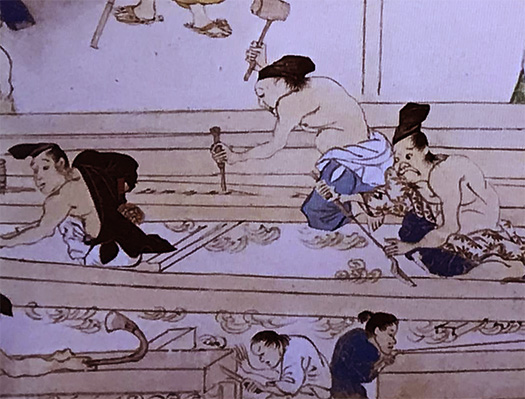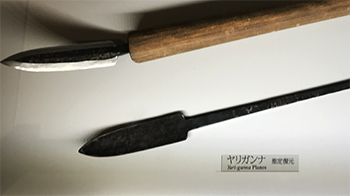

きのうはこの松崎天神社建築に至る政治社会状況、いわば背景をみた。
当時の日本人口は推計で650万人程度といわれる。
北海道の現在人口はおおむね550万人なので、同程度。
そういう社会の最先端建築技術としての木造専門職人はどの程度いたか。
もともと三内丸山や出雲大社などの大型建築はこなしていた社会。
そこに本格的仏教寺院・大阪四天王寺建設(593年)があってデザイン面を含めた
大陸からの木造技術導入も。そのとき最古の技術集団・金剛組が578年に創業記録。
この松崎天神社の創建は903年で菅原道真自身がこの地で葬られることを望んで
死の翌年にこの地に建てられたということですが、一方で縁起絵巻の成立は
1311年と記録されているので、タイムラグがある。
想像できるのは、創建時にはもっと小ぶりな建築であって、
その後、怨霊信仰が社会に根付いてから最初期の「天神社」として重要性が高まり
徐々に本格的建築になっていった可能性。
したがって、この絵巻での建築の様子がどの年代か詳細は不明。
上の写真2枚は竹中大工道具館展示からの画像で、なんといっても
世界的に珍しい「釘を使わない木造技術」がこの段階で確認できるとされる。
縄文の三内丸山遺跡の巨大木組み構造物は材同士は貫通させていない。
接合部に枝のように受け材を取り付け、横架材を柱材に組み合わせている。
一方、吉野ヶ里では材同士で貫通によって木組みが行われている。
この木組みの進化プロセスが日本の木造技術の進化を表現しているとされる。
建材としての木材を組み合わせて「軸組」していくときに
その材木ごとに性格を把握して、接合部の継ぎ手・仕口を考え加工していく。
棟梁技術者は全体としての構造構想をアタマに入れて建材を選び抜き、
それを誤りなく各ディテールごとに組み合わせられるように職人に指示する。
柱に使う材、梁に使う材、その木の生育した環境に合わせたソリの傾向を把握して
適材適所を心がけて行くことになる。当然現場大工もそれを頭に入れて作業する。
微妙な組み合わせ仕口を丹念に造作していく。
人間の手の化身としての道具が選択され、その性能を余すところなく発揮する。
当時の社会では、こういう営為は総合芸術に近いものだったように思える。
建築のための道具は木を切る石斧がすべてのスタートだった。
石器時代から鉄を利用する時代に移行していって
その最先端の道具を利活用していたのが木造大工職人だと思われる。
立派な建築は権力機構のものであったり、宗教的なものであったり、
その存在自体が民への支配の実態でもあっただろう。
そういう建築専門の職人という意味では今日のIT技術者と同等レベルの技術職。


絵巻絵はとくに「ヤリカンナ」を使っている職人さんをクローズアップ。
今日このヤリカンナは実用されることはなくなっているということですが、
写真のような道具で、継ぎ手仕口の細部加工などに多用されていた。
釘を使わないのが基本である木造技術では、こうした木組みが
構造耐力をしっかり確保できるかどうかのキモ部分。
熟練の木造技術者=大工の技量がもっとも発揮された部位だった。
図のように「鑿」とヤリカンナの加工工程が木組みのコア部分だったと推定できる。
はるかな時間を越えて「建築取材」の実感が徐々に強まってくる・・・。
English version⬇
[Over 1000 years of carpentry technology and tool coverage / Japanese good house special edition ㊲-3]
Yesterday I saw the political and social situation leading up to the construction of this Matsuzaki Tenjin shrine, so to speak, the background.
The population of Japan at that time is estimated to be about 6.5 million.
The current population of Hokkaido is about 5.5 million, so it’s about the same.
How many wooden craftsmen were there as cutting-edge construction technology in such a society?
Originally, a society that was able to handle large-scale buildings such as Sannai Maruyama and Izumo Taisha.
There was a full-scale Buddhist temple, Osaka Shitennoji (593), including the design aspect.
Introducing wooden technology from the continent. At that time, the oldest technical group, Kongo Gumi, was founded in 578.
This Matsuzaki Ten Shrine was founded in 903, hoping that Sugawara no Michizane himself would be buried here.
It is said that it was built here the year after his death, but on the other hand, the establishment of the lucky picture scroll
Since it is recorded as 1311, there is a time lag.
I can imagine a smaller building at the time of its construction,
After that, it became more important as the earliest “Tenjinsha” after the spiritual belief took root in society.
It is possible that the building gradually became full-scale.
Therefore, it is unclear what age the architecture in this picture scroll was.
The above two photos are from the Takenaka Carpentry Tools Museum exhibition, after all.
It is said that the world-rare “wooden technology that does not use nails” can be confirmed at this stage.
The huge timber structure at the Sannai-Maruyama site in Jomon does not allow the timbers to penetrate each other.
A receiving material is attached to the joint like a branch, and the horizontal material is combined with the pillar material.
On the other hand, in Yoshinogari, woodwork is done by penetrating the materials.
It is said that the evolution process of this wooden structure expresses the evolution of Japanese wooden technology.
When combining wood as a building material to “frame”
We will grasp the character of each lumber and consider the joints and joints of the joints for processing.
The builder engineer puts the overall structural concept into the head and selects the building materials,
Instruct the craftsmen to combine it for each detail without error.
Understand the lumber used for pillars, the lumber used for beams, and the tendency of sleds according to the environment in which the tree grew.
I will keep in mind the right person in the right place. Of course, the on-site carpenter also keeps that in mind when working.
We will carefully create a delicate combination.
A tool as an incarnation of the human hand is selected, and its performance is fully demonstrated.
In the society at that time, it seems that such activities were close to general art.
A stone ax that cuts wood was the starting point for all the tools for construction.
Moving from the Stone Age to the era of using iron
It seems that the wooden carpenter was making good use of the cutting-edge tools.
Good architecture may be of power organization, religious,
Its existence itself would have been the reality of control over the people.
In the sense of such a craftsman specializing in architecture, he is a technical worker at the same level as today’s IT engineers.
The picture scroll picture is a close-up of the craftsmen who use “Yarikanna” in particular.
It is said that this spear canna is no longer in practical use today,
It was a tool like the one in the photo, and was often used for detailed processing of joint joints.
In the wooden technology, which is basically not using nails, such a wooden structure is used.
The key part of whether or not the structural strength can be secured firmly.
Skilled wooden engineer = the part where the carpenter’s skill was most demonstrated.
As shown in the figure, it can be estimated that the processing process of “chisel” and spear canna was the core part of the wooden frame.
Over a long period of time, the realization of “architectural coverage” gradually strengthens …
Posted on 7月 26th, 2021 by 三木 奎吾
Filed under: 住宅マーケティング, 日本社会・文化研究







コメントを投稿
「※誹謗中傷や、悪意のある書き込み、営利目的などのコメントを防ぐために、投稿された全てのコメントは一時的に保留されますのでご了承ください。」
You must be logged in to post a comment.